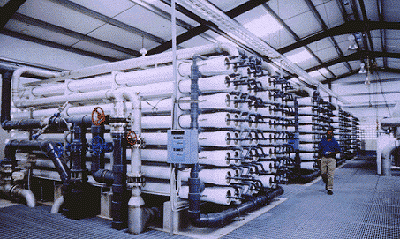New water plant protects island nation against devastation of future droughts
This island nation, which depends heavily on the tourist trade, was suffering lengthy periods without water. Once an entire town was effected. Rainfall simply was not replenishing its supply.
By Ian Lisk
Editor Emeritus, Water Online
Last February an advanced technology water treatment plant went on line on Barbados in the Caribbean. This island nation, said to be one of the most water-scarce countries in the world according to a recent United Nations report, faced a situation several years ago that had to be resolved if the country's economic health was to be maintained and enhanced. A severe dry spell had occurred in 1994 and 1995 and a decision was made to build a new water treatment plant. Construction of the facility began in March of 1999.
Considered a "one in one hundred fifty year" drought, the lack of rainfall frequently caused over three thousand households to be without water for lengthy periods. For example, on July 31 of 1995 virtually the whole of Bridgetown was without water. Rainfall on the island, while adequate to maintain the island's lush vegetation, was not sufficient to replenish the water resources needed to supply the island's population of about 265,000 people.
Drought threatened nation's economy
With Barbados so dependent on its tourism industry, the drought was threatening the island's economy. Plans to develop various tourist attractions, including golf courses, which require a reliable supply of water for maintenance purposes, were put on hold. However, according to David Millington, the chairman of the Barbados Water Authority, the Barbados Government was determined that economic development was not about to be held back by the island's natural shortage of water, and a decision was made to investigate technical options available to alleviate the situation.
Bids were evaluated; other facilities visited
Eight contracting and joint venture companies were pre-qualified to bid on the project and five bids were tendered. A team of directors and engineering personnel from the Barbados Water Authority visited four different treatment plants overseas to evaluate their technology and performance. The team concluded that a facility designed and operated by Ionics, Incorporated, headquartered in Watertown, MA, would be the best choice to solve the particular problems they faced on Barbados. Their decision to select this system was supported by Ambrose Johnson, the project consultant engaged by the water utility.
The Barbados Water Authority actually entered into a 15-year water supply agreement with Ionics Freshwater Ltd., a joint venture between Ionics and its local partner, Williams Industries. This agreement covered design, engineering, equipment manufacture, installation, start-up, commissioning and operation of the new desalination plant in Spring Garden, St. Michael.
The authority effectively selected Ionics to help eliminate all present and future problems caused by drought. Offering water and wastewater systems and services, including membrane-based water desalination, the Massachusetts firm does business around the world.
Desalination system relies on RO technology
At the core of the treatment plant is the Ionics' desalination system that uses reverse osmosis technology to produce drinking water of a high quality. RO is a widely accepted membrane-based technology that in this case separates brackish feed-water into two separate streams—a desalted stream for public consumption and a concentrated discharge that is returned to the ocean through a deep well injection arrangement.

The reverse osmosis section of the plant uses low-pressure elements in combination with a single array to reduce energy consumption.
The design installed in Barbados incorporates a combination of low-pressure brackish water elements and a single array to reduce the plant's energy requirements. During a pretreatment stage any suspended solids, which could foul the RO membranes, are removed from the incoming raw feed. Also, an anti-scalant is added to the process stream to prevent mineral scale build-up, a measure that increases the plant's production efficiency. In the Ionics' desalination design, up to 75% of the pressurized feed-water is recovered as drinking water, while the remaining portion of the high-pressure concentrate passes through an energy-recovery turbine. This contributes to the attractive operating costs observed at the plant, which also is virtually noiseless.
Largest such plant in the world
The plant at Spring Garden, St. Michael is said to be the largest brackish water desalination plant in the Caribbean. It has a capacity of 30,000 cubic meters per day (7.9 mgd), and its drinking water end product is distributed to about 20% of the Barbados population. The facility plays a major role in contributing to the water resources of the island, and in the event of another extended drought will be a valuable asset. It also has enhanced delivered water quality by producing a soft water, whereas in the past the potable water available to residents was hard as a result of the natural mineral content.
